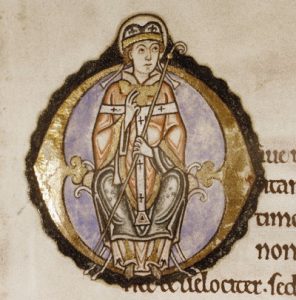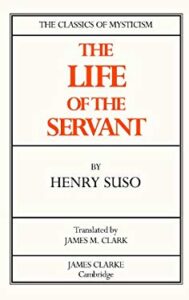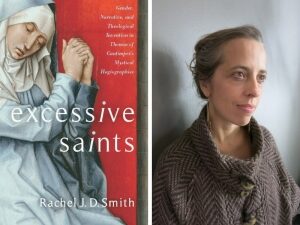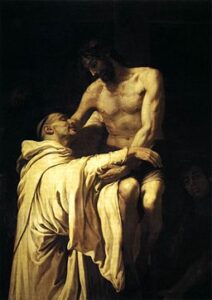Prayer and the Art of Literature in Anselm of Canterbury’s Proslogion
by Robert Glenn Davis
 In this article, Robert Davis reads the Proslogion of the medieval theologian Anselm of Canterbury as a drama of seeking and finding God. He guides the reader through a process of rhetorical inventioi, with all of its attendant risks, pleasures, and discontents. The text opens a space or gap of desire, speaking in the voice of the soul who seeks anxiously to find (invenire) God but turns up only absence. The “I” who speaks and addresses itself to itself and to God learns not to close that gap but to inhabit it, affectively and intellectually, just as the monastic rhetor must, when he directs his inventive activity to God.
In this article, Robert Davis reads the Proslogion of the medieval theologian Anselm of Canterbury as a drama of seeking and finding God. He guides the reader through a process of rhetorical inventioi, with all of its attendant risks, pleasures, and discontents. The text opens a space or gap of desire, speaking in the voice of the soul who seeks anxiously to find (invenire) God but turns up only absence. The “I” who speaks and addresses itself to itself and to God learns not to close that gap but to inhabit it, affectively and intellectually, just as the monastic rhetor must, when he directs his inventive activity to God.
The essay begins:
What was Anselm thinking when he attempted to prove God’s existence in the Proslogion? By the time he wrote the little meditation as a monk at Bec, sometime between 1076 and 1078, he had evidently already offended his teacher, Lanfranc, by “putting aside all authority of Holy Scripture” in advancing his arguments about the nature of God in his Monologion. In the Proslogion, which contains what philosophers of later centuries would call the “ontological argument” for God’s existence, he went further. Here, as the great twentieth-century Anselm scholar Richard Southern writes, “he was on his own, and he stretched out to the furthest limits of his powers. At the end, he trembled with the awe of a new discovery.” This new discovery was not the necessity of God’s existence (of which Anselm was already convinced), but rather the methods of arriving at that certainty. In the Proslogion Anselm eschews, methodically, the evidence of the senses and the authority of the past in order to seek truth through introspection, thinking through the process of thinking itself and through the dynamic of desire that wants to know and feel the truth for and in itself. For this reason, Anselm figures heavily in modern historiographical narratives that posit a “discovery of the individual” and, relatedly, the advent of “affective piety” in eleventh- and twelfth-century Latin Christendom. According to these narratives, Anselm taught generations of late medieval and modern Christians how to turn inward to seek and to find God in the beliefs and desires of the heart.
At the same time, because of what we know of the circumstances of Anselm’s writing, as narrated by the author himself and by his biographer Eadmer, Anselm’s discovery in the Proslogion plays a paradigmatic role in another influential historiographical narrative. In Mary Carruthers’s indispensable studies of memory in medieval European literary culture, the process by which Anselm finds or “invents” his argument bears witness to the profound influence that earlier Roman rhetorical practices had on shaping medieval monastic intellectual and literary production in Western Europe. The activity of rhetorical and literary production (inventio) was, as Carruthers illuminates, an intellectual, affective, and bodily practice. It involved intense effort, time, good luck, and uncertainty. It could lead to frustration and exhilaration, and there was no guarantee that the one would eventually give way to the other. The story of Anselm’s discovery of his argument in the Proslogion is full of such adventures. Yet it has not been fully appreciated, in the wake of Carruthers’s work, how thoroughly the content of the theological meditation in the Proslogion reproduces the circumstances of its authorial production. That is, the Proslogion’s drama of seeking and finding God guides the reader through a process of rhetorical inventio, with all of its attendant risks, pleasures, and discontents. The text opens a space of desire, speaking in the voice of the soul who seeks anxiously to find (invenire) God but only turns up absence. Yet the drama of the Proslogion does not proceed from absence to presence, desire to fulfillment, but rather holds open the distance between them. The “I” who speaks and addresses itself to itself and to God learns not to close that gap but to inhabit it, affectively and intellectually, just as the monastic rhetor must, when he directs his inventive activity to God.
As Michelle Karnes puts it, with reference to the monk’s Prayers and Meditations, “On the topic of distance, no one is more thoughtful than Anselm.” Indeed, Anselm is thoughtful on distance; he is the thinker in the history of Latin Christian thought who perhaps most precisely locates, within distance, the place of thought. Anselm’s meditation on God’s existence in the Proslogion models not only the way in which the gap between desire and fulfillment makes room for thinking and discovery but also the way in which the anguished, uncertain work of inventio can itself be a devotional practice, no less “affective” for its employment of grammatical and logical tools.
Rachel Fulton Brown characterizes the aim of Anselm’s prayers as “a starting point for compunction and fear,” tools for producing in the meditant the emotions that the prayers express. Simply to think of written prayers as tools to be employed in meditation or scripts to be performed, Fulton Brown argues, is insufficiently to appreciate monastic prayer as a skilled profession, a set of habits that took time and practice to develop. While it is a mistake to read Anselm’s emotionally excited prayers as spontaneous expressions of interior experience (his own prefaces warn against such a misreading), this does not mean that medieval monastic tools of prayer—and the long hours spent learning how to use them proficiently—did not aim at producing affective experiences that were no less authentic for being the product of effort and imitation. In her analysis of Anselm’s prayers, Fulton Brown frames the historiography of medieval devotional practices as itself a practical, rather than simply theoretical, challenge. How can one understand the function of a tool without some working knowledge of how to use it?
In recent work, Fulton Brown has written more explicitly about the limitations of modern scholarly approaches to medieval devotion. Her book Mary and the Art of Prayer: The Hours of the Virgin in Medieval Christian Life and Thought, opens with an invitation to the reader to take up the book and pray, to participate in the medieval devotee’s love for the Virgin, “if only for the sake of experiment.” In Fulton Brown’s estimation, historians of medieval devotion still suffer under the legacy of the nineteenth-century turn to the psychology of religious experience, with a resulting “loss of faith” that has rendered the most essential aspect of medieval Christian devotional experience—its divine referent—inaccessible. Fulton Brown argues that historiography focused on the experience of prayer, or even the embodied practice of medieval prayer (to which her work has given much sustained and insightful attention), misses the point, or rather, the “object” of medieval devotion. “Over the centuries, ancient and medieval Christians developed various practices to help train their attention on God . . . always, however, with the conviction that it was not the practice as such that mattered, but rather the object.”
But the sharp divide she draws here between experience and object itself owes more to nineteenth-century assumptions than to medieval devotional practices. In the Proslogion, Anselm again and again directs attention to the practice of prayer that the book enjoins, in ways that ultimately undermine even an analytical distinction between practice and object. The English term “prayer” groups together a range of different activities, not only oratio but also reading/writing (lectio) and ruminative thinking (meditatio/cogitatio), a semantic range that brings into comparative view contemporary practices of writing and scholarship. For Anselm, learning to think well, to use logic appropriately and adventurously, is integral to the cultivation of prayer. The Proslogion models prayer as an activity akin to literary and artistic invention, aiming less to establish a definitive proof (even as it does, in the author’s terms, succeed in this task) than to convey the affective and intellectual habitus of thinking and desiring God that constitutes the practice of prayer.
In Anselm’s writing, that practice is above all directed at opening up the question of the devotional object, that is, at allowing the object of devotion to appear as a question for thought and meditation rather than as a given or even a starting point. I do not mean to deny that Anselm and his contemporaries believed in God, or to deny that they understood God as the object of their devotions. But an approach such as the one Fulton Brown calls for in her putative participant-observation of medieval devotion to the Virgin risks taking for granted the very things scholarship is in a position to interrogate and illuminate. Anselm’s own meditations make insistently clear that, if God’s existence is logically self-evident, the relationship by which God might serve as object (of belief and of devotion) for the meditant is not at all self-evident, but must be rigorously excavated through introspection and exposed to the risk of thought. Or, if such a task is not strictly necessary for proper devotion, it is at least worth a try, if only to see if it can be done. For all the anguish that the Proslogion performs, the author also registers delight at the ludic nature of his devotional experiment. Historians of medieval devotion should aspire to be as adventurous as our subjects in playing with the objects of our practice.
If, as many commentators have demonstrated, Anselm’s Proslogion is best understood as both a devotional exercise and a scholastic argument, perhaps this is not because Anselm managed, against the odds, to integrate two divergent genres. The text might be understood, rather, to trace the practices common to the work of scholarship and devotion. Central to those practices is the work of rhetorical and literary invention, the slow, unpredictable, and experimental work of producing novel thoughts, images, and arguments. As I argue here, the process of literary inventio governs not only the circumstances of the Proslogion’s composition but also the logical-grammatical argument that is its centerpiece. As any writer knows, the process of shaping ideas into a written work requires devotion—a commitment to return, again and again, to a space of frustration, uncertainty, and sometimes even delight and a commitment to following a question through to a hoped-for conclusion that, were it known in advance, would hardly be worth pursuing. Continue reading free of charge for a limited time …
 ROBERT GLENN DAVIS is Associate Professor of Theology and Medieval Studies at Fordham University. He is the author of The Weight of Love: Affect, Ecstasy, and Union in the Theology of Bonaventure, published by Fordham University Press in 2017.
ROBERT GLENN DAVIS is Associate Professor of Theology and Medieval Studies at Fordham University. He is the author of The Weight of Love: Affect, Ecstasy, and Union in the Theology of Bonaventure, published by Fordham University Press in 2017.
Image: An illuminated O featuring an archbishop—presumably Anselm—from the copy of Anselm’s Prayers and Meditations found in MS. Auct. D. 2. 6, a 12th-century illuminated text collected by the Benedictine nunnery at Littlemore and held since c.1672 by Oxford’s Bodleian Library.

 This essay considers an instance of medieval fictionality through the devotional text The Life of the Servant by the Dominican Henry Suso, specifically, through an examination of the “Servant’s” attempt to identify with Christ. Two forms of doubleness issue from this attempt, namely, the human servant seeking to embody the divine without remainder and his figuration as sinner and savior. Insofar as the text allows for a play between these polarities, the servant’s devotional practice can be understood as inhabiting the “as if,” or a kind of fictionality. The temptations of a devotional literalism—fiction striving to overcome its fictionality—is portrayed in the Life alongside a vision of devotion that retains the suspensions and play of the fictional.
This essay considers an instance of medieval fictionality through the devotional text The Life of the Servant by the Dominican Henry Suso, specifically, through an examination of the “Servant’s” attempt to identify with Christ. Two forms of doubleness issue from this attempt, namely, the human servant seeking to embody the divine without remainder and his figuration as sinner and savior. Insofar as the text allows for a play between these polarities, the servant’s devotional practice can be understood as inhabiting the “as if,” or a kind of fictionality. The temptations of a devotional literalism—fiction striving to overcome its fictionality—is portrayed in the Life alongside a vision of devotion that retains the suspensions and play of the fictional. RACHEL SMITH
RACHEL SMITH Like many exegetes before him, the twelfth-century Cistercian abbot Bernard of Clairvaux regarded the lovers in the Song of Songs as allegorical fictions. Yet these prosopopoeial figures remained of profound commentarial interest to him. Bernard’s Sermons on the Song of Songs returns again and again to the literal level of meaning, where text becomes voice and voice becomes fleshly persona. This essay argues that Bernard pursued a distinctive poetics of fictional persons modeled on the dramatic exegesis of Origen of Alexandria as well as on the Song itself. Ultimately, the essay suggests, Bernard’sSermons form an overlooked episode in the literary history of fiction.
Like many exegetes before him, the twelfth-century Cistercian abbot Bernard of Clairvaux regarded the lovers in the Song of Songs as allegorical fictions. Yet these prosopopoeial figures remained of profound commentarial interest to him. Bernard’s Sermons on the Song of Songs returns again and again to the literal level of meaning, where text becomes voice and voice becomes fleshly persona. This essay argues that Bernard pursued a distinctive poetics of fictional persons modeled on the dramatic exegesis of Origen of Alexandria as well as on the Song itself. Ultimately, the essay suggests, Bernard’sSermons form an overlooked episode in the literary history of fiction. JULIE ORLEMANSKI
JULIE ORLEMANSKI